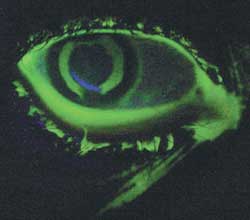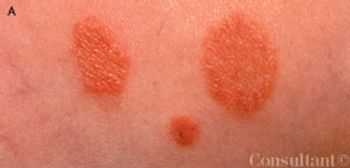
A 43-year-old fireman comes to your office after a routine blood test revealedthat his serum alanine transferase (ALT) level was elevated to approximatelytwice the normal value. The level was confirmed by repeated testing.


A 43-year-old fireman comes to your office after a routine blood test revealedthat his serum alanine transferase (ALT) level was elevated to approximatelytwice the normal value. The level was confirmed by repeated testing.

The last naturally occurringcase of smallpox was reportedin Somalia in October 1977.Despite the eradication ofsmallpox, the causative agent,variola virus, remains in existence.1,2

Although widely regarded as a raredisorder, hereditary hemochromatosisis the most common genetic disease inCaucasians. In certain populations ofnorthern European descent, 1 of every200 persons is homozygous for thecausative mutation.1

Abstract: In the assessment of community-acquired pneumonia, an effort should be made to identify the causal pathogen, since this may permit more focused treatment. However, diagnostic testing should not delay appropriate empiric therapy. The selection of empiric therapy can be guided by a patient stratification system that is based on the severity of illness and underlying risk factors for specific pathogens. For example, outpatients who do not have underlying cardiopulmonary disease or other risk factors can be given azithromycin, clarithromycin, or doxycycline. Higher-risk outpatients should be given a ß-lactam antibiotic plus azithromycin, clarithromycin, or doxycycline, or monotherapy with a fluoroquinolone. If the patient fails to respond to therapy, it may be necessary to do bronchoscopy; CT of the chest; or serologic testing for Legionella species, Mycoplasma pneumoniae, viruses, or other pathogens. (J Respir Dis. 2006;27(2):54-67)

Physicians around the country are being bombarded with questions about avian flu. This brief review of the current status of the avian flu outbreak and its treatment and prevention provides the information you will need to answer the most pressing patient questions.

A 52-year-old man with hypertension and hyperlipidemia presents to the emergency department with a 5-month history of cough and dyspnea.

22-year-old man is hospitalized because of severe hypertension. In addition, he reports exertional retrosternal pressurelike pain, with a severity of 5/10, that lasts for 2 to 3 minutes.

Most primary care practitioners approach the patient who complains of dizziness with some trepidation. This is chiefly because the differential diagnosis involves multiple organ systems and a wide variety of disorders. In this article, I offer a rational, straightforward, and cost-effective approach that uses only minimal, selective diagnostic testing.

A 21-month-old previously healthy child is brought to the pediatrician's office because of increasingly labored breathing that began the night before. The father reports that the child has had fever, congestion, nonproductive cough, and irritability for 2 days and that she is slightly hoarse.

A 22-year-old woman presents with progressive fatigue and dyspnea on exertion that develops after she walks about 30 feet. She also reports orthopnea, lower extremity swelling, weight gain, dry cough, and paroxysmal nocturnal dyspnea.

A pruritic facial eruption; asymptomatic, erythematous lesions;a persistent papule--can you identify the disorders pictured here?

A 5-year-old boy, who lives on a farm and routinely plays with his pet dogs, presented with these scaly, inflamed macules with a central clearingon the abdomen and forehead.

My patient has been hospitalized for pneumonia several times by different physicians. He has never received the pneumococcal vaccine. Can this vaccine begiven during the patient’s hospital stay?

A 51-year-old man who has been hospitalized for 7 days for acute pancreatitis has a predischarge platelet count of 812,000/µL.

There's a curse frequently attributed to the Chinese, "May you live in interesting times." It seems that we find ourselves living in interesting times right now. The Department of Homeland Security recently heightened our threat levelfrom code yellow to code orange. Duct tape, plastic wrap, and flashlights are in short supply at local hardware stores. There’s been more talk about smallpox and the smallpox vaccine, and parents and colleagues are eager for more information.

Practical Pointers: Discover Shortcuts Devised by Colleagues

A 7-year-old girl isbrought to your office by her parents,who state that she has had rednessaround her left eye for the past 2 to 3days. During the last 24 hours, therehas been a marked increase in rednessand soft tissue swelling that hasimpeded the child’s vision. There isno history of trauma or eye infection.

Until recently, the specter of biologicwarfare or bioterrorism was infrequentlydiscussed by most physicians,despite the attention it had receivedfrom novelists, screenplay writers,politicians, and military defense strategists.Thankfully, most physicians havestill never encountered the malevolentuse of biologic agents, nor have theytreated a victim of a biologic attack. Infact, despite their occasional occurrencein a “natural setting,” as well asin recent events, clinical cases involvingany of the classic biothreat agentsare rarely encountered even by mostinfectious disease physicians.

Most pain in or around the oral cavity is attributable to tooth or mucosal pathology. However, tooth or mucosal pain may also be caused by a variety of other conditions, including brain pathology; vascular inflammatory and cardiac disease; jaw infection or neoplasm; neuropathic abnormality not associated with central pathology; pathology in the neck and thoracic region; myofascial and temporomandibular joint pathology; and disease of the ear, eye, or nose, or of the paranasal sinuses, lymph nodes, and salivary glands. Accurate diagnosis is facilitated when the features of pain presentation in this region are understood.

Although penicillin has been the antibiotic of choice for group A streptococcal (GAS) tonsillopharyngitis, a number of other antibiotics are used as well. This includes azithromycin, which may be preferred by some because of its dosing schedule. The results of a meta-analysis by Casey and Pichichero indicate that a total treatment dose of 60 mg/kg of azithromycin is necessary to eradicate GAS tonsillopharyngitis in children, and this regimen appears to be more effective than regimens of other antibiotics studied.

Abstract: Although cystic fibrosis (CF) is typically diagnosed during infancy or childhood, it may escape detection until adulthood. Diagnostic accuracy can be sharpened by maintaining a high index of suspicion for CF in an adult who is pancreatic-sufficient but has unexplained recurrent respiratory infections, bronchiectasis, or nutritional deficiencies. The workup begins with the quantitative pilocarpine iontophoresis sweat test. If necessary, additional tests include mutation analysis, full-gene sequencing of CF transmembrane conductance regulator protein, and measurement of nasal transepithelial potential difference. Multidisciplinary care is essential and includes nutritional support, chest physiotherapy, exercise, appropriate antibiotics, and other pulmonary interventions. Dornase alpha, inhaled tobramycin, and azithromycin have been associated with improved outcomes and are considered to be the standard of care for patients with moderate lung involvement. (J Respir Dis. 2006;27(1):32-41)

The influenza vaccine has been used for many years to control outbreaks of influenza, and its role in reducing morbidity and mortality is widely appreciated among health care professionals and patients alike. The panic that occurred in 2004 after announcements of a vaccine shortage bears testimony to the importance placed on this approach to influenza prevention and control.

Abstract: Shortness of breath is a common complaint associated with a number of conditions. Although the results of the history and physical examination, chest radiography, and spirometry frequently identify the diagnosis, dyspnea that remains unexplained after the initial evaluation can be problematic. A stepwise approach that focuses further testing on the most likely diagnoses is most effective in younger patients. Early bronchoprovocation challenge testing is warranted in younger patients because of the high prevalence of asthma in this population. Older patients require more complete evaluation because of their increased risk of multiple cardiopulmonary abnormalities. For patients who have multiple contributing factors or no clear diagnosis, cardiopulmonary exercise testing can help prioritize treatment and focus further evaluation. (J Respir Dis. 2006;27(1):10-24)

The patient feels well and denies any symptoms; specifically, he has no pruritus, fever, weakness, fatigue, GI symptoms, or cardiac symptoms.

ABSTRACT: A scheme-based approach, supported by a simple mnemonic, can narrow the broad differential diagnosis of thrombocytopenia. This approach uses findings from the complete blood cell count and the peripheral smear to organize the possible causes of thrombocytopenia into those that affect only platelet count, those that produce both a low platelet count and hemolytic anemia, and those that produce disturbances in all 3 blood cell lines. Causes of isolated thrombocytopenia include viral infections, immune-mediated platelet destruction, congenital diseases, gestational thrombocytopenia, conditions in which splenomegaly is a prominent feature, antiphospholipid antibody syndrome, infectious diseases of bacterial origin, and drugs. Causes of thrombocytopenia in conjunction with hemolytic anemia include hemolytic uremic syndrome, thrombotic thrombocytopenia purpura, and disseminated intravascular coagulation. Disorders that produce disturbances in all 3 blood cell lines include aplastic anemia, myeloproliferative syndromes, myelodysplasia (both primary and secondary), myelofibrosis, myelophthisis, and several other diseases in which splenomegaly is prominent.